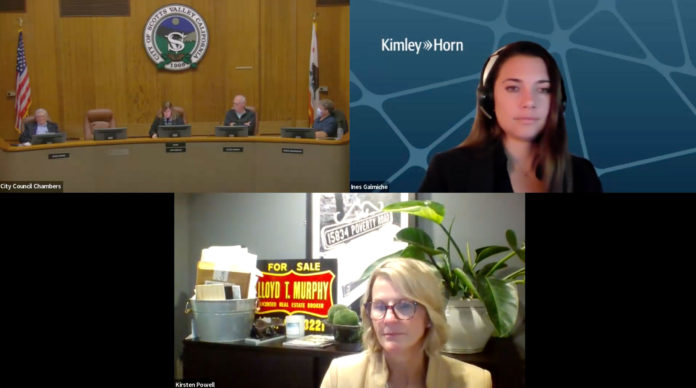Scotts Valley Planning Commission has voted to recommend the city’s Draft Housing Element to the Scotts Valley City Council for approval.
No members of the public spoke during the public comment period, and commissioners engaged in no discussion of the critical planning document before it was rubber-stamped and sent off to Council, during a special meeting Dec. 7.
The Housing Element is meant to cover residential housing development from 2023-31.
“There have been numerous revisions since we last presented before you, so we’ll go over those edits, which stem from reviews in coordination with the State Department of Housing and Community Development (HCD),” said Ines Galmiche, of consultant Kimley-Horn. “The Housing Element is the only Element of the City’s General Plan to require certification by HCD to ensure compliance with all State laws.”
The plan is required to identify sites for 1,220 units of housing to meet the Regional Housing Needs Allocation. The previous cycle required Scotts Valley to plan for 140 units.
“This increase in the housing target is the State recognizing the underproduction of housing state-wide for some time now,” Galmiche said. “It’s important to note, also, that while the City may assist in the development of affordable housing through programs and funding sources, it’s not the direct role of the City to itself construct housing. Rather, the City is responsible for ensuring that the adequate opportunities exist for housing development through zoning, by removing regulatory impediments to housing production.”
Scotts Valley’s housing element includes two main chapters and eight appendices.
Kimley-Horn pointed to nine community-engagement efforts, including presentations to Council and Planning Commission, draft releases, two community workshops and one-on-one stakeholder meetings, held this November.
“We’ve had a number of opportunities for public engagement and receiving comments from the public,” she said.
The numbers have shifted around a bit, but here’s where they’ve landed: Scotts Valley has decided to plan for 2,166 total new homes—which leaves a 78% buffer above the RHNA mandate.
More than half of these (1,102) will be above moderate income units (164% more than it’s required to include); 168 moderate income units (9% more than required); and 896 low and very low income units (which includes a 38% buffer above the minimum).
This is slightly different from what was in the draft released May 19, although the overall buffer has not shifted.
Planners have eliminated 10 low and very low income units and added three above moderate units. The moderate income unit projections didn’t change.
The City has established five strategies to achieve these targets: existing land already zoned residential, previously-submitted projects, granny flats and the development of the Town Center site (where it’s pledging to allow 427 lower-income units to spring-up).
During an official review of an earlier draft, the State raised questions about concentrating so many poorer people in a single area—instead of spreading out people of lower socioeconomic status across all census tracts.
It’s unclear how satisfied HCD will be with the minor modifications the City has made since then.
Los Gatos officials were recently surprised by how hard the agency’s reviewer (who happens to be the same person looking over Scotts Valley’s drafts) was on their most recent Housing Element submission.
But Kimley-Horn has settled on several strategies it believes will help Scotts Valley get the policy prescription over the finish line, including:
- Actions to facilitate ADU developments;
- Removing parking requirements from multi-family developments;
- An Affirmatively Furthering Fair Housing program;
- Updating the City’s definition of “family” (to remove limitations on the number of people and the differentiation between related and unrelated people living together);
- A program to amend zoning to permit employee housing;
- Updates to requirements for emergency shelters; and
- Reworking the Density Bonus Ordinance to comply with new State laws.
“We began our review with HCD in September,” Galmiche recalled, adding initial improvements focused on four areas.
The Housing Plan was updated to add-in timelines for programs and policies.
“Here we had heard that some of the programs that we had identified included language that was a little too vague,” she said.
The Housing Constraints appendix was rejigged to add more information about affordable housing constraints.
The Affordably Furthering Fair Housing section added comparisons between Scotts Valley and the wider region.
And the Sites Inventory was updated with more information about pipeline projects, the Town Center Specific Plan, and opportunities for rezoning.
“Once these revisions were completed, the draft was posted for a seven-day public review, and resubmitted to HCD,” she said.
After receiving an official comment letter from the State, Kimley-Horn made further adjustments:
- It did a deeper analysis of the previous Housing Element cycle’s effectiveness;
- The Housing Plan chapter was further revised with refined timelines;
- The Housing Needs Assessment was spruced-up related to past performance and with updated programs;
- More elaboration went into the Housing Constraints portion of the Draft;
- Scotts Valley made a stronger case for how the sites it selected will “affirmatively further fair housing”; and
- Details were added about the likelihood of rezone sites to be developed.
Scotts Valley wasn’t able to secure an additional conversation with HCD to find out if it’s on-track or not, prior to the meeting.
Planning Commission Vice Chair Chuck Maffia’s only question was whether staff felt the document was good-to-go or not.
“We’ve made the determination that we are substantially in compliance,” said Community Development Director Taylor Bateman.
Planning Commission Chair Lori Gentile thanked staff and the public who came out to provide input in recent months.
Maffia made a motion to recommend the document as-is to Council, with Commissioner David Hodgin seconding. Commissioner Shawn Mosley was absent.













